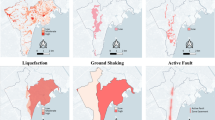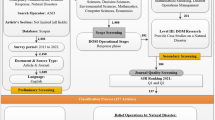Abstract
In this paper, we construct a multi-objective location and channel model for ULS network to alleviate the urban traffic congestion problem. First, we construct a multi-objective node selection model and obtain the position of the first-level nodes in the ULS network by using agglomerative hierarchical clustering method. Then, we obtain the position of the second-level nodes in the ULS network by using the greedy algorithm. We also calculate the service scope, actual traffic volume and transport rate of first-level node for each node based on the determined node group. After that, we select the optimal channel scheme to make nodes at different levels of the ULS and its load more balanced by using the plant growth simulation algorithm. We extract the key variables of the problem, quantify some indicators with reasonable quantification, construct a multi-objective location and channel model based on the actual logistics situation for the specific region and achieve reasonable results to meet multiple objectives. Therefore, the model could be used as a reference for the construction of urban ULS network.




Similar content being viewed by others
References
Zujun MA (2004) Urban underground logistics system and its design. Logist Technol 10:12–15
Zhang G, Bao D-H (2017) Survey and analysis on underground logistics system. Value Eng 36(29):242–245
Visser J (2001) Underground logistics systems for goods distribution in urban areas: perspectives in the Netherlands. City Logist II:287–302
van der Heijden MC, van Harten A, Ebben MJR (2002) Using simulation to design an automated underground system for transporting freight around Schiphol Airport. Interfaces 32(4):1–19
Vernimmen B, Dullaert W, Geens E et al (2007) Underground logistics systems: a way to cope with growing internal container traffic in the port of Antwerp. Transp Plan Technol 30(4):391–416
Zhu J, Huang K, Pu Y, et al (2007) Research on optimization model for urban underground logistics system. In: International conference on transportation engineering, pp 4192–4197
Yangguang JIANG, Dajun PANG (2009) Analysis on locations for urban ULS logistics links based on set covering model. Logist Sci-Technol 32(10):54–55
Delft T (2012) Pipe logistics contractor opens new Houston headquarters. Undergr Constr 67(3):69
Tong Li, Zhongtuo Wang (2013) Optimization layout of underground logistics network in big cities with plant growth simulation algorithm. Syst Eng-Theory Pract 33(04):971–980
Zhou T, Zhou A-L (2016) Optimization model of distribution route in underground logistic system based on the time-cost. Logist Eng Manag 38(08):60–62
Minghui WU, Hongxi Z, Changhong J et al (2014) Cluster algorithm based on edge density distance. Comput Sci 41(8):245–249
Bentley JL (1992) Fast algorithm for geometric traveling salesman problem. ORSA J Comput 4(4):387–411
Adamczyk M (2011) Improved analysis of the greedy algorithm for stochastic matching. Inf Process Lett 111(15):731–737
Ribas I, Companys R, Tort-Martorell X (2011) An iterated greedy algorithm for the flowshop scheduling problem with blocking. Omega 39(3):293–301
Tong LI, Chunfeng WANG, Wenbo WANG et al (2005) A global optimization bionics algorithm for solving integer programming-plant growth simulation algorithm. Syst Eng-Theory Pract 1(01):76–85
Yiping HUANG, Qin YANG, Qing LI et al (2017) The delivery vehicle scheduling considering agents’ perception satisfaction toward waiting time. Ind Eng J 20(4):31–48
Author information
Authors and Affiliations
Corresponding author
Ethics declarations
Conflict of interest
We declare that we have no financial and personal relationships with other people or organizations that can inappropriately influence our work; there is no professional or other personal interest of any nature or kind in any product, service and/or company that could be construed as influencing the position presented in, or the review of, the manuscript entitled.
Rights and permissions
About this article
Cite this article
Liang, H., Yuan, G., Han, J. et al. A multi-objective location and channel model for ULS network. Neural Comput & Applic 31 (Suppl 1), 35–46 (2019). https://doi.org/10.1007/s00521-018-3636-5
Received:
Accepted:
Published:
Issue Date:
DOI: https://doi.org/10.1007/s00521-018-3636-5




